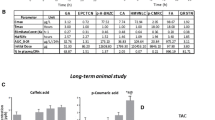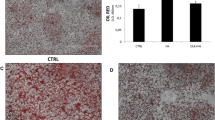Abstract
Purpose
Regular consumption of extra virgin olive oil (EVOO) is associated with a low incidence of atherosclerotic diseases. The phenolic component contributes to the hypolipidemic action of EVOO, although the biochemical mechanisms leading this beneficial outcome are not fully understood. Since liver plays a pivotal role in the whole body lipid homeostasis, we investigated the short-term effects of EVOO extract, with a high phenol content (HPE), on lipid synthesis in primary rat hepatocytes. Refined olive oil extract, with a low phenol content, was used throughout this study as a control.
Methods
Olive oil phenols isolated with methanolic extractions were subsequently analyzed by high performance liquid chromatography, electrospray ionization tandem mass spectrometry, and gas chromatography mass spectrometry. Rat hepatocytes were obtained from collagenase perfusion of liver. A colorimetric assay was performed to exclude cytotoxicity of the extracts. Radioenzymatic methods were used in order to investigate hepatic lipid metabolism.
Results
HPE, dose- (0.1–50 μg/mL) and time-dependently (0.5–4 h) inhibited both lipogenesis and cholesterogenesis (n = 6, P < 0.05), as well as triglycerides synthesis (n = 5, P < 0.05). We showed that these effects are attributable to a short-term modulation by HPE of the key enzymes implicated in the abovementioned pathways (n = 5, P < 0.05).
Conclusions
The decrease in hepatic lipid synthesis may represent a potential mechanism underlying the hypolipidemic effect of EVOO phenols.






Similar content being viewed by others
References
Tijburg LB, Mattern T, Folts JD, Weisgerber UM, Katan MB (1997) Tea flavonoids and cardiovascular disease: a review. Crit Rev Food Sci Nutr 37:771–785
Covas MI, Konstantinidou V, Fitó M (2009) Olive oil and cardiovascular health. J Cardiovasc Pharmacol 54:477–482
Yusuf S, Hawken S, Ounpuu S, Dans T, Avezum A, Lanas F, McQueen M, Budaj A, Pais P, Varigos J, Lisheng L (2004) Effect of potentially modifiable risk factors associated with myocardial infarction in 52 countries (the INTERHEART study): case-control study. Lancet 364:937–952
Galli C, Visioli F (1999) Antioxidant and other activities of phenolics in olives/olive oil, typical components of the Mediterranean diet. Lipids 34:S23–S26
Visioli F, Poli A, Galli C (2002) Antioxidant and other biological activities of phenols from olives and olive oil. Med Res Rev 22:65–75
Visioli F, Galli C (2002) Biological properties of olive oil phytochemicals. Crit Rev Food Sci Nutr 42:209–221
Pérez-Jiménez F, Ruano J, Perez-Martinez P, Lopez-Segura F, Lopez-Miranda J (2007) The influence of olive oil on human health: not a question of fat alone. Mol Nutr Food Res 51:1199–1208
Boskou D (2000) Mediterranean diets. In: Visioli F, Simopoulos AP (eds) World review nutrition and diet, vol 87. Karger, Basel, pp 56–77
Fragaki G, Spyros A, Siragakis G, Salivaras E, Dais P (2005) Detection of extra virgin olive oil adulteration with lampante olive oil and refined olive oil using nuclear magnetic resonance spectroscopy and multivariate statistical analysis. J Agric Food Chem 53:2810–2816
Weinbrenner T, Fitó M, de la Torre R, Saez GT, Rijken P, Tormos C, Coolen S, Albaladejo MF, Abanades S, Schroder H, Marrugat J, Covas MI (2004) Olive oils high in phenolic compounds modulate oxidative/antioxidative status in men. J Nutr 134:2314–2321
Coni E, Di Benedetto R, Di Pasquale M, Roberta M, Modesti D, Mattei R, Carlini EA (2000) Protective effect of oleuropein, an olive oil biophenol, on low density lipoprotein oxidizability in rabbits. Lipids 35:45–54
Dell’Agli M, Maschi O, Galli GV, Fagnani R, Dal Cero E, Caruso D, Bosisio E (2008) Inhibition of platelet aggregation by olive oil phenols via cAMP-phosphodiesterase. Br J Nutr 99:945–951
Petroni A, Blasevich M, Salami M, Papini N, Montedero GF, Galli C (1995) Inhibition of platelet aggregation and eicosanoid production by phenolic components of olive oil. Thromb Res 78:151–160
De la Puerta R, Ruiz-Gutierrez V, Hoult JR (1999) Inhibition of leukocyte 5-lipoxygenase by phenolics from virgin olive oil. Biochem Pharmacol 57:445–449
Carluccio MA, Siculella L, Ancora MA, Massaro M, Scoditti E, Storelli C, Visioli F, Distante A, De Caterina R (2003) Olive oil and red wine antioxidant polyphenols inhibit endothelial activation: antiatherogenic properties of Mediterranean diet phytochemicals. Arterioscler Thromb Vasc Biol 23:622–629
Carluccio MA, Massaro M, Scoditti E, De Caterina R (2007) Vasculoprotective potential of olive oil components. Mol Nutr Food Res 51:1225–1234
Jemai H, Bouaziz M, Fki I, El Feki A, Sayadi S (2008) Hypolipidemic and antioxidant activities of oleuropein and its hydrolysis derivative-rich extracts from Chemlali olive leaves. Chem Biol Interact 176:88–98
Covas MI, Nyyssönen K, Poulsen HE, Kaikkonen J, Zunft HJ, Kiesewetter H, Gaddi A, de la Torre R, Mursu J, Bäumler H, Nascetti S, Salonen JT, Fitó M, Virtanen J, Marrugat J (2006) EUROLIVE Study Group. The effect of polyphenols in olive oil on heart disease risk factors: a randomized trial. Ann Intern Med 145:333–341
Visioli F, Caruso D, Grande S, Bosisio R, Villa M, Galli G, Sirtori C, Galli C (2005) Virgin Olive Oil Study (VOLOS): vasoprotective potential of extra virgin olive oil in mildly dyslipidemic patients. Eur J Nutr 44:121–127
Ramirez-Tortosa MC, Urbano G, Lopez-Jurado M, Nestares T, Gomez MC, Mir A, Ros E, Mataix J, Gil A (1999) Extra-virgin olive oil increases the resistance of LDL to oxidation more than refined olive oil in free-living men with peripheral vascular disease. J Nutr 129:2177–2183
Priore P, Sicullella L, Gnoni GV (2014) Extra virgin olive oil phenols down-regulate lipid synthesis in primary-cultured rat-hepatocytes. J Nutr Biochem 25:683–691
Del Coco L, Schena FP, Fanizzi FP (2012) 1H nuclear magnetic resonance study of olive oils commercially available as Italian products in the United States of America. Nutrients 4:343–355
Montedoro GF, Servili M, Baldioli M, Miniati E (1992) Simple and hydrolysable phenolic compounds in virgin olive oil. 1. Their extraction, separation, and quantitative and semiquantitative evaluation by HPLC. J Agric Food Chem 40:1571–1576
Cardoso SM, Guyot S, Marnet N, Lopes-da-Silva JA, Renard CMGC, Coimbra MA (2005) Characterization of phenolic extracts from olive pulp and olive pomace by electrospray mass spectrometry. J Sci Food Agric 85:21–32
Visioli F, Galli C, Bornet F, Mattei A, Patelli R, Galli G, Caruso D (2000) Olive oil phenolics are dose-dependently absorbed in humans. FEBS Lett 468:159–160
Mangiullo R, Gnoni A, Leone A, Gnoni GV, Papa S, Zanotti F (2008) Structural and functional characterization of F(o)F(1)-ATP synthase on the extracellular surface of rat hepatocytes. Biochim Biophys Acta 1777:1326–1335
Mosmann T (1983) Rapid colorimetric assay for cellular growth and survival: application to proliferation and cytotoxicity assays. J Immunol Methods 65:55–63
Priore P, Giudetti AM, Natali F, Gnoni GV, Geelen MJH (2007) Metabolism and short-term metabolic effects of conjugated linoleic acids in rat hepatocytes. Biochim Biophys Acta 1771:1299–1307
Giudetti AM, Leo M, Geelen MJ, Gnoni GV (2005) Short-term stimulation of lipogenesis by 3,5-L-diiodothyronine in cultured rat hepatocytes. Endocrinology 146:3959–3966
Geelen MJH (2005) The use of digitonin-permeabilized mammalian cells for measuring enzyme activities in the course of studies on lipid metabolism. Anal Biochem 347:1–9
Natali F, Siculella L, Salvati S, Gnoni GV (2007) Oleic acid is a potent inhibitor of fatty acid and cholesterol synthesis in C6 glioma cells. J Lipid Res 48:1966–1975
Gnoni GV, Paglialonga G, Siculella L (2009) Quercetin inhibits fatty acid and triacylglycerol synthesis in rat-liver cells. Eur J Clin Invest 39:761–768
Gnoni GV, Paglialonga G (2009) Resveratrol inhibits fatty acid and triacylglycerol synthesis in rat hepatocytes. Eur J Clin Invest 39:211–218
Fabiani R, Sepporta MV, Mazza T, Rosignoli P, Fuccelli R, De Bartolomeo A, Crescimanno M, Taticchi A, Esposto S, Servili M, Morozzi G (2011) Influence of cultivar and concentration of selected phenolic constituents on the in vitro chemopreventive potential of olive oil extracts. J Agric Food Chem 59:8167–8174
Vissers MN, Zock PL, Katan MB (2004) Bioavailability and antioxidant effects of olive oil phenols in humans: a review. Eur J Clin Nutr 58:955–965
de la Torre R (2008) Bioavailability of olive oil phenolic compounds in humans. Inflammopharmacology 16:245–247
Dell’Agli M, Fagnani R, Galli GV, Maschi O, Gilardi F, Bellosta S, Crestani M, Bosisio E, De Fabiani E, Caruso D (2010) Olive oil phenols modulate the expression of metalloproteinase 9 in THP-1 cells by acting on nuclear factor-kappaB signaling. J Agric Food Chem 58:2246–2252
Tunstall-Pedoe H, Kuulasmaa K, Mahonen M, Tolonen H, Ruokokoski E, Amouyel P (1999) Contribution of trends in survival and coronary-event rates to changes in coronary heart disease mortality: 10-year results from 37 WHO MONICA Project populations. Lancet 353:1547–1557
De Lorgeril M, Salen P, Martin JL, Monjaud I, Delaye J, Mamelle N (1999) Mediterranean diet, traditional risk factors, and the rate of cardiovascular complications after myocardial infarction: final report of the Lyon Diet Heart Study. Circulation 99:779–785
Martín-Peláez S, Covas MI, Fitó M, Kušar A, Pravst I (2013) Health effects of olive oil polyphenols: recent advances and possibilities for the use of health claims. Mol Nutr Food Res 57:760–771
Cicerale S, Lucas L, Keast R (2010) Biological activities of phenolic compounds present in virgin olive oil. Int J Mol Sci 11:458–479
Gimeno E, Fitó M, Lamuela-Raventós RM, Castellote AI, Covas M, Farré M, de La Torre-Boronat MC, López-Sabater MC (2002) Effect of ingestion of virgin olive oil on human low-density lipoprotein composition. Eur J Clin Nutr 56:114–120
Davis RA, Hui TY (2001) 2000 George Lyman Duff Memorial Lecture: atherosclerosis is a liver disease of the heart. Arterioscler Thromb Vasc Biol 21:887–898
Verschuren WM, Jacobs DR, Bloemberg BP, Kromhout D, Menotti A, Aravanis C, Blackburn H, Buzina R, Dontas AS, Fidanza F, Karvonen MJ, Nedelijković S, Nissinen A, Toshima H (1995) Serum total cholesterol and long-term coronary heart disease mortality in different cultures. Twenty-five-year follow-up of the seven countries study. JAMA 274:131–136
Fitó M, de la Torre R, Covas MI (2007) Olive oil and oxidative stress. Mol Nutr Food Res 51:1215–1224
Semenkovich CF (1997) Regulation of fatty acid synthase (FAS). Prog Lipid Res 36:43–53
Jemai H, Fki I, Bouaziz M, Bouallagui Z, El Feki A, Isoda H, Sayadi S (2008) Lipid-lowering and antioxidant effects of hydroxytyrosol and its triacetylated derivative recovered from olive tree leaves in cholesterol-fed rats. J Agric Food Chem 56:2630–2636
Park S, Choi Y, Um SJ, Yoon SK, Park T (2011) Oleuropein attenuates hepatic steatosis induced by high-fat diet in mice. J Hepatol 54:984–993
Mangge H, Becker K, Fuchs D, Gostner JM (2014) Antioxidants, inflammation and cardiovascular disease. World J Cardiol 6:462–477
Williams RJ, Spencer JP, Rice-Evans C (2004) Flavonoids: antioxidants or signalling molecules? Free Radic Biol Med 36:838–849
Acknowledgments
This work was supported by Grants from Apulia Region (Italy), PON 01_01958 PIVOLIO.
Conflict of interest
The authors declare that they have no conflict of interest.
Ethical standards
The manuscript does not contain clinical studies or patient data.
Author information
Authors and Affiliations
Corresponding author
Rights and permissions
About this article
Cite this article
Priore, P., Caruso, D., Siculella, L. et al. Rapid down-regulation of hepatic lipid metabolism by phenolic fraction from extra virgin olive oil. Eur J Nutr 54, 823–833 (2015). https://doi.org/10.1007/s00394-014-0761-5
Received:
Accepted:
Published:
Issue Date:
DOI: https://doi.org/10.1007/s00394-014-0761-5




